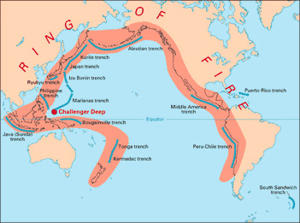'Ring of Fire' rumbles through the Pacific: are we about to see more destructive earthquakes?

The Pacific Ring of Fire experiences hundreds of earthquakes every dayAn angry 'Ring of Fire' has been setting off quite a few earthquakes around the Pacific Ocean over the past day, and it seems to be concentrating its ire on just a few specific areas.
There have been over 300 earthquakes around the edges of the Pacific Ring of Fire over the past day. The Ring of Fire is the 40,000-km-long, vaguely horseshoe-shaped region around the eastern, northern and western sides of the Pacific Ocean where numerous earthquakes happen ever day — with a little over 70 that were strong enough to be felt. This isn't really strange overall, as that represents a fairly average day according to the U.S. Geological Survey earthquakes website, but what is a little usual about it is that, instead of being spread out a bit more around the 'ring', over three-fourths of them, including several of the strongest, are clustered in just three areas.
It started yesterday afternoon, at 1:19 p.m. Eastern Time, when a magnitude 7.4 quake struck southwest of the island of Tonga, in the South Pacific, which was followed up by three significant aftershocks of magnitude 6.5 down to 5.0, and then another 5.8 aftershock this morning. Despite the power of the quake, it was likely only lightly felt in nearby Tonga, and perhaps in Fiji, and no tsunami warnings were issued.
Then, last night at around 11:47 p.m. Eastern Time, residents around Greenville, California had a rude shock when a magnitude 5.7 quake rattled the area. There were no damages or injuries reported, but the quake has been followed by nearly 50 aftershocks since then — most fairly light, but one early this morning registered as magnitude 4.9 — and the aftershocks are continuing into this afternoon.
The strongest of these earthquakes took place at around 1:45 a.m. Eastern Time, when a powerful magnitude 8.3 quake struck under the Sea of Okhotsk, off the coast of eastern Russia. The quake was very deep in the earth's crust, about 600 kms down, so it was only felt lightly in nearby communities and it didn't touch off any tsunami warnings. However, it now ranks as the strongest earthquake so far this year, and it could be the strongest earthquake ever recorded at that depth below the ground — beating out the magnitude 8.2 quake on June 9, 1994, in Bolivia, that was at a depth of 647 km.
Is this significant? Should we be worried about a 'Big One' happening soon?
Anyone living in earthquake-prone areas should be prepared with a plan and probably disaster supplies, but just because an earthquake happens in an area doesn't mean another one will happen there, or further along the same fault line, or even around the same tectonic plate. In some cases, small tremors have happened before a larger quake, but that's never been a reliable way of predicting them, as smaller quakes happen all the time. Aftershocks are, of course, common after an earthquake, but even those can't be accurately predicted.
Although there is research being put into forecasting earthquakes (such as the hints that the behaviour of ants might indicate when one may be about to strike), the science just isn't there yet. Most earthquake prediction now simply uses 'risk levels', which basically state the chance an area has to experience one, based on what has happened in the area in the past.
Comparing what we've had so far this year to what happened by this time last year... although we're running behind in the total number of significant (5.0+) earthquakes (592 this year, compared to 779 last year), we've already beaten last year's total for quakes of magnitude 6.0 or stronger (70 this year, compared to 65 last year). Also, although less than 1% of the quakes felt in most years are the more powerful ones (magnitude 7.0+), so far for 2013, we're running at over 1.5%.
So, we're definitely seeing a higher proportion of stronger quakes this year, and sadly we've had more than double the number of fatalities from earthquakes so far as well (293 this year so far, compared to 140 by this time last year).
Whether or not that will be balanced out by the rest of the year being more sedate is yet to be seen, though.
--
__._,_.___
No comments:
Post a Comment